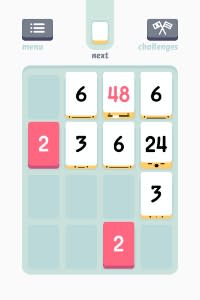Portabliss: Threes
This is Portabliss, a column about downloadable games that can be played on the go.

Imagine a house party in a minimalist, white studio apartment, where the easy, simple decor belies a mixed group of partygoers. For some, introductions and flirtations come effortlessly, while others are more shy. For all the many people, the atmosphere is one of constant effervescence and the collective always mingles as one, its faces and sounds shifting and changing as the night bubbles on.
Now imagine that as an addictive puzzle game with numbers. Don't worry if you cannot, because Threes already exists.
To casually glance at Threes, you wouldn't sense its foxy personality. In its heart of hearts, the iOS game is a matching puzzler with numbers, which sounds like the opposite of sexy. That said, even when you discount its style, Threes isn't a conventional matching game.
Each session starts with a four-by-four grid, with a few spots taken up by tiles with small numbers on them. Swiping left, right, up, and down moves all the tiles in that direction. You start by swiping a red 1 into an adjacent blue 2 to make a 3 tile, and after that you combine number-matching tiles: Swipe a 3 into another 3 to get 6, pair two 6s for a 12, and so on. The idea is to build up larger and larger multiples of 3, and avoid filling up the grid.

As with many a great puzzle game, simple rules betray the depth that unravels. Threes is all about attending to the big multiples like 96, 192, and 384, while making space for the smaller component numbers, and keeping it all ticking along as a threes-building engine. It's an exercise in planning ahead – a good Threes player is always aware of the displayed Next tile, and the unknown possibilities beyond it – but even planning ahead is hard when you've got a grid with more 3s in it than a Reggie Miller highlight reel.
Without doubt, Threes has lasting power because of the depth beyond the simplicity. Like any good flirt, however, the game hooks you in by turning on the charm.
If you didn't look at Threes, but just listened to the music and sounds emanating from it, you'd be forgiven for thinking you were in a lounge bar. As a jaunty, Euro-tinted bit of pseudo-jazz plays in the background, the numbers enter the grid as if they were announcing themselves at a party. Each spoken hello is different: Some of the smaller numbers let out a meek little "Hi," while others are more confident and sensual, offering "Mmhmms" and "Oh yeahs!"

As the numbers grow larger, they become more memorable. 48 is dorky but friendly, making his entrance with a nasal "Hey guys!" Then there's 192, a hedonistic-sounding gent who bellows a hearty "Well, hello ladies and gentlemen!" The numbers' personalities extend beyond their speech, thanks to the little faces on their tiles. 384 wears a pirate mask, and makes innuendos about being boarded, while the vampire-like 768 sports a fine pair of wings. Not that'll you see too much of him, mind you, unless you get very good at Threes.
There's not a whole lot of variation there, and the music loops and loops. It should get annoying after some 100 or 200 goes, but somehow it doesn't. A bit like the Tiny Wings theme, it's all pleasant and unobtrusive enough to just filter through, like the background hum of a get-together with friends.
Threes could do with a little more to push its score-chasing, like showing your own high score to beat as you play, but its personality carries it through when it feels too tough. Moreover, once you start getting good at Threes, you'll want to master it. You'll end each session with a nagging feeling that you played one wrong move, that you could've done a bit better, that you will do a bit better.
Soon enough, you don't want to leave the party. Just one more go, you plead, as you chug down another glass of tile-swiping sweetness. All the while, the numbers say their charming hellos and continue to have a good time.
This review is based on an iTunes download Threes, purchased by the reviewer. Images: Sirvo, LLC.

